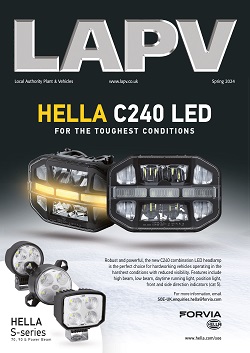Geesinknorba has developed a system that handles different combinations of bins and RFID chips and weighs very accurately without pausing the lifting cycle down. The company believes it has set a new technological benchmark,which will have universal appeal.
It's probably just a matter of time before Britain fully embraces paid for waste and recycling collections. The industry has so far struggled to find fully functional weighing systems that work for everyone.
The Geesinknorba Dynamic Weighing System (GNDS) was initially developed to handle multiple types of RFID chips which some systems can't. It even works if a hoist simultaneously picks up two domestic bins embedded with chips operating at different frequencies, which confuses some systems. And it manages 100% accuracy with steel bins which also cause interference in other systems.
Geesinknorba's UK Business Director Geoff Rigg said: “A lot of bins in the UK have already been chipped to operate at 125kHz. GNDS reads them without any difficulty and handles HDX chips operating at 134.2khz just as easily. However, we know some manufacturers' lifts can't read both types of chip.
“Fitting chips, labeling bins and matching IDs to owners, addresses and locations has proven to be very labour-intensive and problematic for some systems. Our scanning tool combines all the customer information with location and chip ID and generates the label. It's even more efficient if we fit bins with chips before distribution. And rather than leave customers to do this themselves, as suppliers of some systems do, GNDS customers won't have to do anything. We can arrange it all, quickly and efficiently.”
As soon as a bin is mounted on the lift the GNDS reads the ID. It can be set up to reject bins without a valid chip, to allow manual override or to simply accept all bins. It can highlight bins in the wrong location, bins reported missing or bins whose owner's account is on “stop”.
It can even be set up to operate with “blacklists” - rejecting the bins of customers who haven't paid ' or “whitelists” ' only allowing approved bins to be emptied. And if contracts are based on “collections per year” it can highlight and charge accounts exceeding their limit.
The GNDS then records weight, GPS location, date and time, encrypts signal and sends it to the operations server by GPRS which is more reliable than GPS. If there is no signal the transmitter keeps trying to send until it dies get a signal. Any data collected in the meantime is stored until it can be sent and none is ever lost.
“Some weighing systems save data on a card which has to be taken out of the vehicle when it returns to the depot, inserted into a PC and downloaded,” explained Geoff Rigg.
“It can be very time-consuming and when cards get damaged data is lost. If a problem arises with GNDS and data from a vehicle is not received for a period, an alarm can sound in the operations centre and the diagnostic software identifies the problem so the driver can be alerted quickly.”
The digital system weighs domestic bins to within +/-1kg during a superfast seven second cycle. In trade collections, with heavier bins and where lifting speeds are less critical, it achieves the same impressive +/-1kg in a 14 second cycle. The system is fully compliant at these settings for customs weights and measures certification.
“The GNDS weighs while it lifts so as not to slow the collection down,” said Geoff Rigg.
“It takes up to 100 measurements on the way up and down. A 'dummy' acceleration cell compensates for other factors ranging from temperature to tilt of the vehicle and it can reject bins for being too heavy. We think this all adds major value to GNDS. “Some weighing systems slow the operations down. Some systems even pause mid- lift to get measurements, which drives crews mad ' we've even heard stories from abroad of crews sabotaging them for their own sanity's sake.”
On that note, the digital load cell monitors itself and alerts operators if it has been shocked, perhaps after a collision. Not that it is likely to happen as the load cells are carefully positioned for protection. In fact the whole GNDS system is hard to see on a vehicle.
“We've mounted the display panel on the side of the demo vehicle so we can show it off to groups of people but normally this would be in the cab,” said Geoff Rigg.
“Apart from that, you'd hardly notice it was fitted because everything is carefully concealed.”
Away from the vehicle itself, the Windows-based software can either be integrated with customers' own IT systems or can be run centrally by Geesinknorba. There's no need to buy expensive hardware. The reports it produces are tailored to show whatever is needed, such as who is not recycling or who produces the heaviest bins ' which unless they are operating on a pay-per-weight contract could leave operators out of pocket.
Geoff Rigg added: “The GNDS will be on display at the RWM Show, where we will be operating products as part of our outside stand area ' Stand numbers OA250 and OA190. We also plan to exhibit a good cross section of our range as part of an expanded stand area for 2011.”

